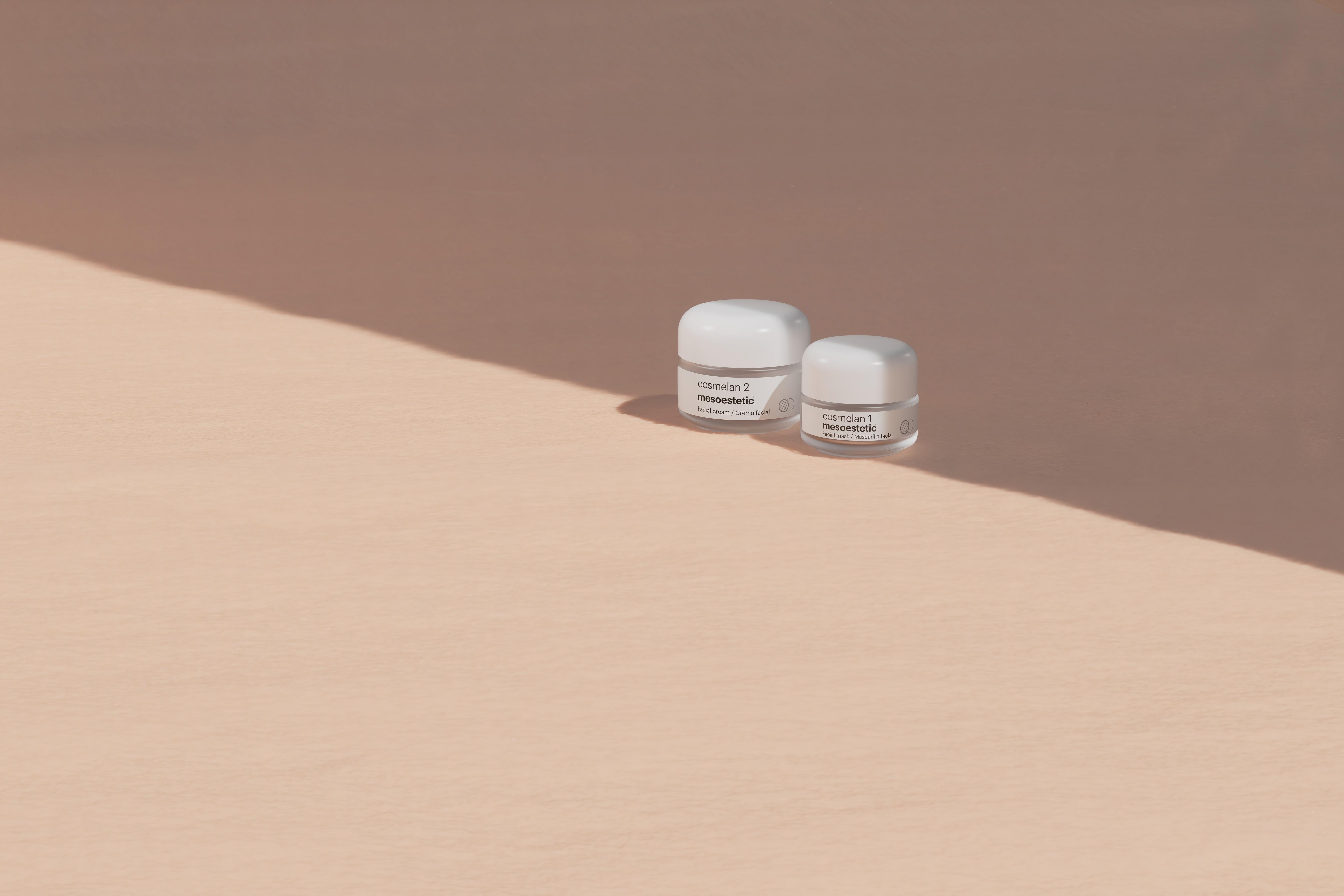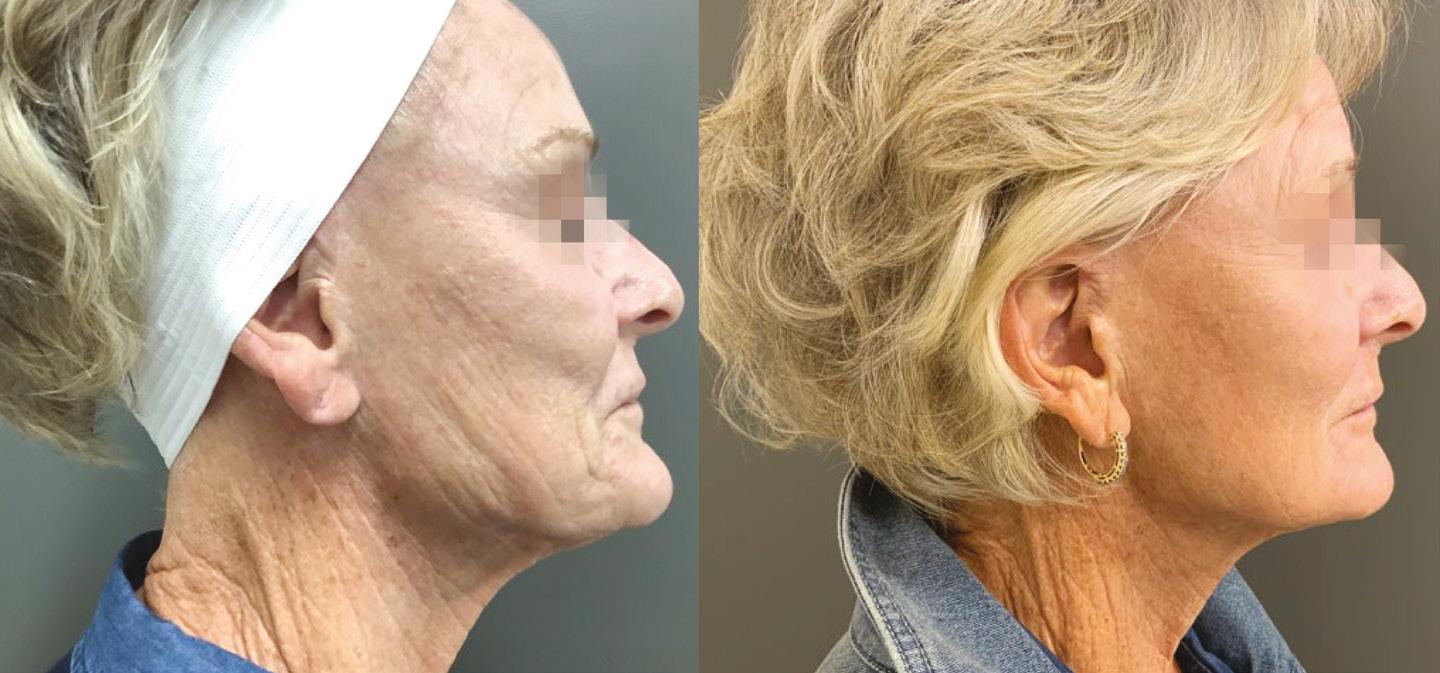
11 minute read
Managing Photodamage
Treatment considerations
Nurse prescriber Anna Baker provides an introductory overview of the treatment options for photodamage
Advertisement
Skin ageing is a complex multifactorial phenomenon with many intrinsic and extrinsic influences.1 Cutaneous changes can also be influenced by ethnic origin in light of underlying structural and functional differences.2 Intrinsic ageing reflects the genetic background of an individual and occurs progressively with time. Chronologically aged skin manifests thinning, fine lines, soft tissue descent and fat atrophy.3 Skin of colour demonstrates less severe intrinsic facial ageing, often with visible signs appearing approximately a decade later than lighter skin types.2 Consistent with other organs, the skin undergoes a gradual decline to the accumulation of molecular damage.4 During menopause, women may experience accelerated skin ageing due to declining oestrogen levels, which greatly influence the skin’s appearance.5 Flattening of the epidermal/dermal junction influences the structural integrity of the epidermis and can reduce nutrient flux between the epidermis and dermis which can negatively impact keratinocyte proliferation.6 Melanocyte number, as well as activity, are altered which triggers a cascade of pigmentary changes across different skin types.7 The dermis loses volume and density, alongside decreased collagen production and deranged organisation of the elastin content in the skin.8 Extrinsic skin ageing arises mainly from UV light exposure.9 Approximately 80% of facial skin ageing can be attributed to UV exposure.10 The effects of UV radiation are based on light absorption in chromophores and the conversion of energy in chemical reactions.11 Cumulative UVA and UVB radiation contributes to potentially irreversible and detrimental effects, resulting in skin ageing and photocarcinogenesis.10 Short wave UVB is mainly absorbed in the epidermis, causing DNA damage by producing cyclobutene pyrimidine dimers (CPDs).12
Extrinsic ageing is also influenced by individual health status, amount of sun exposure, tobacco inhalation and diet.13 Cumulative sun exposure is one of the detrimental factors in ageing skin, and in skin types III-VI, dyspigmentation is one of the most common features of photoageing.14 Common clinical signs of photoageing include lentigines, rhytides, telangiectasias, dark spots and loss of elasticity.15 Skin of colour is less susceptible to sun-induced damage, and therefore these age-related changes are less severe and may occur 10-20 years later than Caucasian skin of a similar age.16 Mechanistically, photodamaged skin is affected by elevated matrix metalloproteinases (MMPs), which degrade collagen fibrils in the skin. In addition, there are significant alterations in collagen, characterised as damaged and disorganised fibrils with an accumulation of elastic material (solar elastosis).17 Taking time to explore and educate patients around the contributing factors is key to achieving the best outcomes, as well as maintaining and preventing future damage. Many modalities and approaches are described in the literature to counteract the different attributes of photodamage.18 It is increasingly acknowledged that a combined approach utilising a bespoke regimen can provide the best possible treatment outcomes but may be influenced by individual compliance. A prescribed regimen can be tailored to include the following key factors: the degree of photodamage, willingness to adopt/compromise with lifestyle choices (such as sun exposure or diet), anatomical area to be treated, frequency of attending clinic appointments and specified budget, as well as expected time frame to achieve desired results.19
Treatment options
The treatments that are briefly summarised are not intended to be exhaustive, but can be considered some of the more popular modalities, both as standalone and as combination approaches.
LED phototherapy LED phototherapy provides an affordable and effective treatment option for all skin types, as well as a diverse range of skin conditions on the face and body.20 Near infrared (830 nm) and red (633 nm) provide a powerful antiageing combination which collectively energises cells to repair, regenerate, boost collagen and elastin production, promoting healthy skin and reducing signs of pigmentation.21 The mechanisms of action are based on the same principles as photosynthesis, known as photobiomodulation, which means that the light is absorbed by target cells to activate specific biological functions.22 A number of critical factors are key considerations with regard to achieving successful treatment outcomes with LED: principally, the correct wavelength, dose, energy and treatment time.20 LED provides an excellent standalone or combination treatment with any regimen to target signs of photodamage and overall antiageing.23
Mesotherapy Mesotherapy is a type of injectable skin biorevitalisation treatment which combines linear (non-stabilised) hyaluronic acid (HA)
with a specific combination of amino acids, vitamins and minerals.24 It is a popular treatment option that can target a number of age-related concerns on the face and body and typically comprises multiple small quantities of a HA complex injected intradermally.25 One of the principle benefits of mesotherapy for photodamaged skin is the HA carrier which hydrates the extra-cellular matrix, allowing the additional ingredients to stimulate key extracellular matrix proteins through targeting fibroblasts.26 The biorevitalising effect that is achieved through a course of mesotherapy lies within the different biological effects of the cocktail of substances, as the synergy of ingredients improves many age-related changes including photodamage, to deliver both curative and preventative benefits.26
Bioremodelling Injectable bioremodelling is a process which triggers a regenerative cascade through the three main layers of the skin, utilising a patented hybrid, stabilised, injectable, hyaluronic acid technology to address signs of poor skin quality and areas of laxity, commonly seen in photodamaged skin.27 The injectable utilises a patented stabilisation which is based on stable hybrid cooperative complexes of high-and low-molecular-weight HA (H-HA and L-HA), without the addition of chemical agents.28 This is formulated in high concentrations of 64mg in a 2ml syringe for the face and neck, and 96mg in a 3ml syringe for areas on the body. An initial course of two to three treatments at a one-month interval elicits the regenerative benefits to improve elasticity, hydrate, tighten and firm the skin, which visibly improves these types of concerns seen in photodamaged skin.29
Microneedling Microneedling, also known as collageninduction therapy, involves repetitive puncturing to the skin with sterilised microneedles.30 The needle injury generates growth factors which stimulate the production of collagen and elastin in the papillary layer of the dermis.31 The diverse applications of microneedling permit it to be used for transdermal delivery of other solutions, such as mesotherapy, as well as a combination approach with other modalities like LED.32 It is a popular treatment option to specifically improve textural skin concerns, such as coarseness, elastosis and uneven pigmentation, commonly seen in photodamaged skin.33 Combining energy (radiofrequency) with microneedling is an increasingly popular skin rejuvenation (fractional resurfacing) treatment to correct signs of photodamage, specifically for textural changes, elastosis and improved elasticity.

Chemical peels The term chemical peel broadly refers to procedures which are chemically based, treating specific concerns on the face and body.34 The common mechanism which underpins many peel formulations is to elicit a specific type or level of stimulation which can trigger healing, repair or collagen synthesis specific to the type of peeling agent used. Chemical peels can treat a diverse range of skin concerns, and are a popular treatment choice to improve photodamage. The mechanism of the ingredients in the formulation can influence the depth and target structures, and may be tailored to the severity of the photodamage and anatomical area being treated. Chemical peel selection may be influenced by the clinician and patient’s preference, as well as individual professional scope of competence.34 Other key factors can include the nature and concentration of the peeling agent, number of applications, contact time on the skin and varying degrees of desquamation.33 Commonly used peeling agents formulated to tackle signs of photodamage include: lactic acid, glycolic acid, citric acid, gluconolactone, trichloroacetic acid, phenol and vitamin A compounds.35
Laser and IPL Intense pulsed light (IPL) utilises polychromatic, non-coherent light covering a broad spectrum from 510 nm to approximately 1200 nm.36 The principle of treatment is selective thermal damage of the target. The combination of prescribed wavelengths, fluences, pulse durations and pulse intervals facilitates the treatment of a wide variety of skin conditions.37 It is a popular course of treatment for treating a number of symptoms of photodamage, such as telangiectasias, skin texture/roughness and hyperpigmentation.38 Treatment for extensive/severe photodamage can respond well to ablative/non-ablative fractional laser technologies.39 Using ablative laser systems, the superficial layers of skin are ablated, including epidermal and superficial dermal actinic damage.40 When using a CO2 laser, additional cosmetic improvements are a result of removal and tightening of the photodamaged collagen in the superficial dermis. Scarring and dyspigmentation are associated risks, but can be lessened using fractional lasers, which produce small columns of ablation or coagulation, but leave the surrounding skin intact.41
Topical ingredients A bespoke topical regimen is a critical factor to optimise in-clinic treatments, and ultimately maintain results. A number of treatment modalities, such as chemical peels and laser, often require a period of acclimatisation to ensure that the skin barrier is healthy, intact and in good condition. Many of the effects of photodamage can be successfully addressed using a topical combination of ingredients – often as a standalone treatment, depending on the presentation of the skin. A considerable number of ingredients are described in the literature and supported for addressing the effects of photodamage. Popular choices are vitamin C, bakuchiol, retinol, chemical exfoliants (citric and glycolic acid), tranexamic acid, arbutin, phytic acid and lactic acid.41 A broad spectrum UVA/UVB SPF is key to underpin any regimen and clinic treatments.
Educate your patients
Collating a detailed patient history is key in facilitating recognition of the clinical features of photodamage, as well as exercising increased vigilance and skin surveillance in patients with this concern. Aesthetic practitioners are well placed to educate patients around the risk of cumulative damage from prolonged and/or unprotected UV exposure. Practitioners can also convey important messaging around adopting a healthy and balanced approach to sun exposure for optimal health, while mitigating the risk of developing photodamage and more sinister skin diagnoses.42
Anna Baker is an aesthetic prescribing nurse, trainer and qualified educator. She is a key opinion leader and also a board member of the British Association of Cosmetic Nurses (BACN) and jointly leads on the BACN education and training committee. Qual: BN, RGN, INP, PGCert, PGDip
VIEW THE REFERENCES ONLINE! AESTHETICSJOURNAL.COM
13 & 14 Oct ExCeL London, UK
Anna Baker will be speaking at CCR on October 14, turn to p.20 to register for free.

The Evolution of RF Microneedling
Discover the next generation of radiofrequency microneedling treatments
Radiofrequency microneedling is constantly growing in popularity within the aesthetic specialty, and there are continued advancements in its technology. With four radiofrequency modes, nine different needle configurations and customisable energy, the Potenza device is the world’s first radiofrequency microneedling (RFM) system that combines monopolar and bipolar RF at 1 or 2MHz frequencies in a single device. The four RF modes allow you to treat a larger variety of conditions both superficial and deep, producing clinically superior results for almost all ageing concerns.
What is Potenza? The Potenza device combines the mechanical injuries created by its ultrafine needles with the radiofrequency dose delivered into the dermis where it will trigger a natural repair mechanism inducing the creation of both collagen and elastin. Both deep tissue and more superficial concerns can be targeted by adjusting the needle depth in .25mm increments. Potenza offers a greater variety of needle arrays to attach onto the handpiece, meaning that it is more customisable in treating a bigger variety of scars on the face and the body.
Tiger tip technology Potenza’s Tiger tip is a semi-insulated needle array which allows delivery of the energy at two depths simultaneously. This means that fewer passes are needed, as two layers are treated in one pass, resulting in shorter treatment times.
The Fusion tip Potenza also offers a unique tip designed to enhance topical penetration by up to 67%.1 The Fusion tip operates in monopolar at 1MHz for deep and wide RF delivery and enhanced tissue engagement and topical penetration, with 21 insulated needle arrays and an adjustable depth of 0.5-2.5mm. Patient suitability Potenza is a highly versatile treatment offering for all Fitzpatrick skin types for the face and the body. Sun exposure isn’t a limiting factor to this treatment in the way that laser therapy is, making it a more flexible option for patients of all skin types, all year round.
Expected results Improvement in the skin can be observed from the first or second treatment, however the patient may need three to five treatments dependent on the desired result. The treatment interval is four to six weeks apart to allow more time for healing.
Side effects The device is minimally invasive, so pinpoint bleeding is expected at the time of treatment and patients experience a sunburn sensation with some swelling. However, this typically resolves in 24-48 hours and mineral makeup can be worn from the next day to cover any residual redness.
Before After Practitioner perspective Dr Kaywaan Khan, aesthetic practitioner and founder of Hannah London Medispa, commented, “Potenza is a cut above older technology. It provides practitioners with the ultimate freedom and flexibility as it has a unique propensity to customise the intensity and distribution of energy for different parts of the body or face. This means not only can multiple concerns be addressed, but there are also fewer passes needed – resulting in minimal downtime for the patient and maximum return on investment for the user.”
This article was funded by Cynosure

For more information on the device visit www.cynosureuk.com
REFERENCES
1. Cynosure, Potenza the new standard in RF microneedling, <https://www.cynosureaustralia.com/potenza-the-new-standardin-rf-microneedling/#:~:text=Cynosure%E2%80%99s%20
Potenza%20takes%20the%20world%E2%80%99s%20next%20 step%20towards,penetration%20up%20to%2067%25%20 with%20the%20Fusion%20Tip.>










